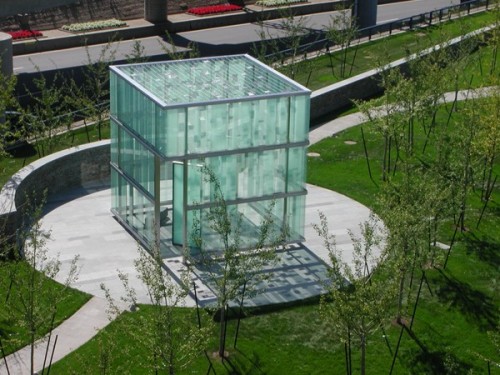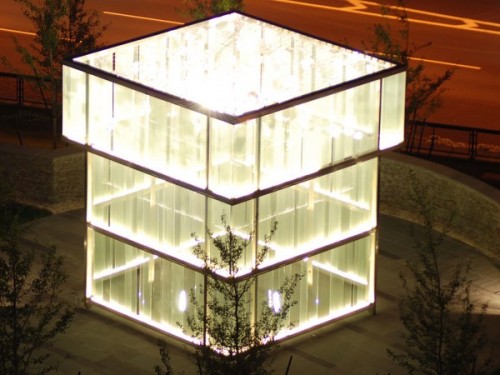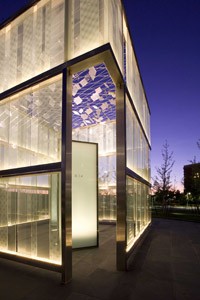Boston's Logan Airport's 9/11 Memorial
A Reflective Structure to a Tragic Memory
By: Mark Favermann - Sep 11, 2008
September 11, 2001 is a day that lives in infamy. Like the day JFK was shot and along with December 7, 1941, those who were alive can describe in detail where they were and what they were doing. I was in York, England at a museum when I heard the horrible news. I was told to go to a pub to watch the Twin Towers smoking and then one collapsing. It took me over a week to get back home. Now seven years have past since the terrorist attack. Even though due to ego wars, incompetence, politics and bureaucracy, New York City's Ground Zero is still not built, a number of memorials have been constructed and unveiled around the country. A few days ago Boston's Logan Airport's 9/11 Memorial was dedicated.
Memorials are a design challenge. There is no right way or wrong way to create them. However, some are much better than others like the inspired Viet Nam War Memorial in Washington, D.C., the Oklahoma City Bombing Memorial and Boston's Holocaust Memorial. Most are mundane, often inelegant or awkward and rarely transcendent. By definition, a memorial is an object which serves as a physical or symbolic memory of something, usually a person or an event, signifying death or a tragedy or often both. Popular forms of memorials include landmark objects or icons such as sculptural elements, fountains or parks. The most common type of memorial is the gravestone or marker. Each type integrates grief and memory.
Almost immediately after the tragedy of 9/11, several communities and governmental agencies rushed to start memorial committees that developed into competitions to create recognition projects. Some actually became inspired visual statements, while most others only reflected a haste to make a community statement of grief and acknowledgement. It was their communal obligation.
This past week a new memorial was dedicated at New England's largest airport, Logan international. It is a memorial commemorating the awful events of that ironically sunny morning in September of 2001. This is a place designed to be for reflection and remembrance dedicated to all of those affected by the events of September 11, 2001. The seriousness of purpose cannot be more underscored. The cost of the landscaping and memorial was just under $4 million.
According to Massport, the administration agency for the airport, the 9/11 Memorial honors the passengers and crews of American Airlines Flight 11 and United Airlines Flight 175, which departed Logan Airport that morning for Los Angeles. The Memorial also commemorates the dedication to duty of the Logan Airport community in restoring the aviation system to full operation and the contributions its members made toward comforting the families of the passengers and crew who were aboard those flights.
Logan's 9/11 Memorial is located on a 2.5 acre site adjacent to the Boston Logan Airport Hilton Hotel. The hotel served in 2001 as the headquarters for Massport's Critical Assistance Relief Effort (CARE) Team which assisted family members in the aftermath of the 2001 attacks. The Memorial is built primarily of stainless steel and tempered plate glass. There are mirrored small pieces in the ceiling that are set to reflect the sky and the sunlight, literally a shattered sky underscoring a shattered unthinkable day.
The Memorial site is anchored by a rectalinear glass sculptural structure that encases two glass vertical panels. Each panel is etched with the names of the passengers and crew of each flight. The landscape attempts to echo New England natural visual elements with grey fieldstone walls, a lawn and trees that will change color each autumn.
According to the memorial's designers Moskow Linn Architects, Inc., it is meant to symbolize the break between the world before and after the tragedy, to refocus a view from earth to sky, to honor the passengers and crew and to create a place to reflect and remember. Interestingly, at the point of entry for the memorial, visitors follow one of two winding walkways that echo the flight paths of American Airlines Flight 11 and United Airlines Flight 175. These walkways lead through a grove of now sparse Ginkgo trees to what the architects refer to as The Place of Remembrance.
Designing a major memorial is a difficult creative challenge. High sounding phrases and thoughtful symbolic structures may not be enough to truly commemorate the significance of the memory, the tragedy of the event or the feelings of loved ones and friends. Here, there needs to be more, perhaps, a much more resonating form of more sensitive and deliberate use of space and materials.
Though the Logan 9/11 Memorial is physically related to other memorials aesthetically through its use of glass and steel in the context of a park, the piece lacks a certain visual coherence. It seems small. even somewhat diminished in regard to the adjacent hotel and the larger airport environment and nearby busy, continuous and noisy traffic. This tragedy was a large, no--massive even earth-shattering event, not a small one. Contemplation and remembrance suggest quiet and reflection. This setting seems to strategically weaken this thematic approach.
The memorial is compacted and therefore it feels a bit stunted. The structure is too simple and uninspired rather than elegant. There is nothing that speaks clearly to either tragedy or hope. The panels that include the times of departures of the two planes and the names of all onboard seem commercial and awkward sized. Are the panel shapes reflective of the Twin Towers or just tall rectangles visually and physically blocking the two entrances of the structure?
The problem is that this 9/11 memorial has no poetry, only a rather stiff prose. Though it took five years from open competition to completion, maybe this project needed more time to germinate. And though I have not seen it lit at night, the daylight version is visually less accomplished than expected. Perhaps, internally illuminated, the structure is more inspiring, more reverberating.
The initial premise of this project was to memorialize the two planes' passengers and crews slain during a tragic event. But what is the memorial echoing about these individuals? Already local Boston press has quoted victims' family members as saying that they wanted to remember their loved ones at their best not at their most awful ending, not just one of the names on a ill-fated passenger list.
Art and especially public art each has the ability to transform space, to reflect important feelings and to underscore shared emotions through the use of artistic tools and techniques, appropriate materials manipulation and the reflection of beauty, either sublime or visceral. Unfortunately, this 9/11 memorial shows little of these attributes.
This was a project that began with all the right intentions. Its sponsor Massport should be commended for following through with its implementation. Public agencies often do not do the right thing. Massport has tried to do the right thing, but good intentions are sometimes just not always enough. Perhaps, in the future, when the trees grow fuller and the natural landscape seems more whole, this memorial will appear better, more complete. Currently, like the September 11, 2001 tragedy itself, the Logan 9/11 Memorial feels unresolved.




